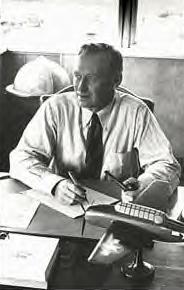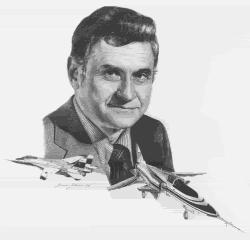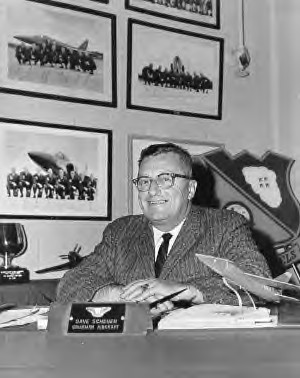


Leroy R. Grumman
January 4, 1895 – October 4, 1982
Founder of Grumman Corporation
"We always tried to do a solid job."
Leroy Randle Grumman was born Jan 4, 1895, in Huntington, Long Island. He graduated second in his high-school class and went on to earn a degree in mechanical engineering from Cornell University in 1916. Leon A (Jake) Swirbul was born March 18, 1898, in Manhattan, but his family moved to Long Island when he was a child. He grew up in Sag Harbor and he, too, went to Cornell, but in 1917 left to join the Marine Corps. Grumman joined the Naval Reserve and entered a course in airplane inspection for pilot trainees at the Massachusetts Institute of Technology. He received advanced flight training in Pensacola, was commissioned an ensign, and became a flight instructor. Later the Navy again sent Grumman to MIT to study the then-new discipline of aeronautical engineering.
Grumman and Swirbul met in 1924 at Loening Aeronautical Engineering Co in New York City, one of the many small aircraft firms that sprang up after World War I. In 1919, when the firm landed a contract to build 50 planes for the government, the Navy sent Grumman to oversee construction. He so impressed the Loenings that they hired him. Jake Swirbul, who had worked in aircraft shops after the war, became a civilian inspector for the Air Corps, which brought him to Loening in 1924. When Loening sold out to Keystone in 1929, rather than move to Bristol, Grumman, Swirbul, and Bill Schwendler, a Loening engineer, decided to start a new company. Grumman mortgaged his house, and Swirbul's mother borrowed $6,000 to set up Grumman Aeronautical Engineering Co. Schwendler joined them, along with two other men who would be the company's inner circle of management for the next 50 years: Ed Poor and E Clinton Towl. Towl traveled to Baldwin to look over a small building that faced south to the Long Island railroad tracks near Grand Avenue. Once the Cox-Klemin aircraft factory, it had become an abandoned auto garage, but it would be where the new company came into official being on Jan 2, 1930, with $64,325 capital. It was the wrong time to go into business. The stock market had crashed weeks before and the nation was heading into the Great Depression. At first, all the company had was a contract to repair damaged Loening amphibians, but that was only a means of keeping the front door open. The real hope was to get contracts to produce aircraft for the Navy. The company had been nudged in this direction by a Navy admiral of Grumman's acquaintance who hinted that anyone who came up with a good retractable set of landing wheels for Navy amphibians might make a fortune. While Leroy Grumman worked on the retractable wheels, the company, which had hired some former Loening mechanics, paid the bills by using its metal-working skills to produce aluminum truck bodies.
In time Grumman first received a contract to build pontoons for the Navy, then another to build two prototype fighter planes. The XFF-I was a stubby two-seater biplane, with a fat fuselage designed to accommodate its retractable landing gear, a first in military aviation. Despite its bulk, it was very fast, 198mph in level flight—a competing Boeing fighter could only achieve 178 mph. Grumman got $75,000 for the two prototypes and a contract for 37 more. An order for more planes followed, and Grumman was off the ground. There were hard times in those early years, to be sure. Money was so tight that Grumman and Swirbul would pick up scrap metal from roadsides for use in the shop. But the peculiar mix of Grumman's and Swirbul's talents quickly began to shape an unusual and successful company that expanded and moved to bigger quarters to Valley Stream in 1931, Farmingdale in 1932, finally Bethpage in 1937. Leroy Grumman's shyness was well known, but no one presumed to take advantage of him. Indeed, it had the odd effect of increasing workers' respect. Most recognized that Grumman's shyness concealed what one man called "a whim of iron." While everyone in the plant felt comfortable calling Swirbul "Jake," no one ever called Grumman anything but "Mr. Grumman." There was no doubting his skill as an airplane designer. He was, said one engineer, "a master of the educated hunch" who could foresee technical problems and their solutions. He also knew the Navy intimately and seemed able to anticipate their demands. Swirbul devised a management style that was uncommonly successful in creating a profitable and smooth-running corporation. As competitors soon discovered, his style was easy to admire but very hard to emulate. His system wasn't hierarchical; questions did not have to go to the top of the executive pyramid to get answers. If someone saw something that had to be done, he or she did it. With Swirbul as its organizing genius, Grumman in the 1930s was just the sort of company that Leroy Grumman wanted: small, familial, and incidentally profitable—on the eve of World War II it was hardly an industrial giant. Then in 1940 France and Britain ordered F4F Wildcats, the 330-mph fighter planes that Grumman had first flown in 1937.
Few companies responded as well as Grumman to the challenge that followed Pearl Harbor. Employment went from 700 in 1939 to 25,500 in 1943. Grumman's sales for 1940 were $4 million; 1943 sales were 100 times that. The production floor was prodigious. In 1944 the Navy had to ask Grumman to slow its production to 500 airplanes a month after Swirbul said they could build 700. In March, 1945, Grumman built a record 664 aircraft. Secretary of the Navy James Forrestal said, "In my opinion, Grumman saved Guadalcanal." F6F Hellcats once shot down 369 Japanese aircraft in a single da, and on a good day, Grumman could turn out 27 Hellcats. Grumman Co accomplished all this without changing the fundamentals of its management. Grumman's technical brilliance brought innovative and marketable airplanes, while Swirbul kept morale up with his inspired, and sincere, paternalism. Designing new planes was challenging, but building them in wartime with an available force of untrained workers was even more difficult. Swirbul set up training programs for new employees, in some cases outside the company plant. Employee loyalty was such that turnover during the war was half that of other aircraft plants, and the company's profit margin was better as well. Grumman succeeded by keeping things simple, even at the height of wartime production. The company never overreached, and ranked seventh among airplane makers during World War II. It ran lean. In 1948, it had an engineering staff of 500, compared with more than 2,000 at the Martin Co. During the war, Grumman's operating profit held around 10 percent, while other aircraft makers watched theirs slip as low as 4 percent. In 1946, Grumman showed a profit when all other airplane makers posted losses. As the war's end neared, Grumman and Swirbul faced a new problem: With Navy war contracts about to be canceled, they had to shrink the company without killing it. The smaller post-war company was much to Grumman's liking, and he set about designing several small civilian airplanes. Only one succeeded, the AgCat, a crop-dusting biplane that they licensed to another manufacturer, who produced 2,646 of them. With the Korean War in 1950 came a contract for hundreds of S2F Tracker anti-sub planes. Many executives thought that was too much to handle, but Swirbul convinced them to take everything they could get and, as it turned out, there were 700 orders that the company delivered over a period of about 10 years. Grumman's no-frills management was responsible for other successes. In a meeting took less than four minutes, it was decided to risk building the civilian executive Gulfstream in the late '50s. Grumman sold more than 200 Gulfstreams and turned a profit after the first two dozen.
Swirbul died in June, 1960, just as the company began a space program that would put the Grumman-made Apollo Lunar Module on the moon before the end of the decade. Grumman Co closed its doors for a day so that thousands could attend his services. Grumman didn't live to see his company acquired by Northrop in 1994. He retired at 71 from an active role in 1966. A smaller crowd turned out for his funeral in Manhasset in Oct 1982—time had thinned the ranks of those who remembered his presence and role in a company that made history, as well as airplanes.
George M. Skurla
July 2, 1921 – September 2, 2001
President Grumman Aerospace Corporation, 1974-1985
Upon graduation from the University of Michigan in 1944, George Martin Skurla began his 42-year career at Grumman as an apprentice engineer. He worked on many projects including the Aerobilt trailer bodies, but he will be most remembered for heading up the Florida operations for the Lunar Module. In 1973, Skurla became general manager of Calverton operations and revitalized production of the F-14 Tomcat. Elected president of Grumman Aerospace Corporation in 1974, he held this post until becoming president of the parent organization, the Grumman Corporation, in 1985. Skurla retired in 1986.
Thomas J. Kelly
January 1, 1927 – March 23, 2002
President of Space Station Integration Division, led design team of Lunar Module
"My only regret is that I wasn’t able to go to the moon myself. I would have loved to go. It was a great adventure."
Born in Brooklyn and raised in Merrick, NY, he attended Wellington C. Mepham High School in Bellmore. Attended Cornell University's five-year engineering program in 1946 on a Grumman scholarship.
He joined Grumman Aircraft Engineering Corporation full time as a propulsion engineer when he graduated and stayed until his retirement in December 1992, leaving only to serve in the Air Force from 1956 to 1958.
Tom Kelly led the design team for Lunar Module when Grumman received the contract from NASA in late 1962. Kelly had not yet turned 40 when Neil Armstrong took his historic first step on the moon in 1969. "It was the greatest thing in my career. And, in hindsight, it was even more significant than we thought at the time," Kelly said in 1998.
After his work on the lunar module, he served as the vice president and deputy director of Grumman's space shuttle proposal and president of Grumman's Space Station Integration Division in Reston, Va., among other positions. He was awarded NASA's Distinguished Public Service Medal in 1972 for his work on Project Apollo.
In May 2001, he published a book titled "Moon Lander: How We Developed the Apollo Lunar Module," which his family said took six years to complete and was in its second printing. On Saturday, March 23, 2002, at the age of 72, Tom Kelly passed away after a long battle with pulmonary fibrosis at his home in Cutchogue. Dave "Grandfather" Scheuer
– May 6, 2002
Blue Angels Service Representative 1951 - 1969,
Honorary Flight Leader, Consultant
Dave Scheuer went to work for Grumman Aircraft Engineering Corporation early in 1942. He installed hydraulic systems and was a trouble-shooter on the TBF Avenger.
He and two other men installed the first hydraulic system on the F6F Hellcat. After testing, the complete system was removed and sent to Plant 2 to be manufactured for installation on the three lines of Hellcats patiently waiting for their hydraulic systems to be installed.
Dave then became Foreman of a newly formed Hydraulic Department in Plant 4. His department's responsibility was the installation of shortages and final testing for Company and Navy inspection. The aircraft would then be ready for its first flight.
After doing jobs for the Ground Training Departments at NAS quonset and NAS Atlantic City, Dave was asked to join the Service Department as a Company Representative. He covered Naval Air Stations along the East Coast of the United States.
Dave soon found himself in the Pacific Theater in the Admiralty Islands and the Philippines. After his tour of duty ended, he returned home. The war ended, and the Service Department personnel were relegated to other duties.
In late 1951, Dave was asked to assist the Blue Angels, who were re-forming in Corpus Christi, Texas. He remained with the Team until early 1969, at which time the Blues transitioned to the F-4 Phantom.
Dave retired from Grumman in late 1973. His wife, Ginny, died the next month after a long illness.
Dave had three daughters, Susan, Ginger and Lynda, six grandchildren, David, John, Ginny, Suzy, Mary Kate and Elizabeth. He also had two great grandsons, Chris and Muhammad. He lived in Pensacola, Florida, and was still known as "Grandfather" to the Blue Angels. There has never been a man more beloved by all the Blue Angels, from the beginning to now. Dave passed away on May 6, 2002.


